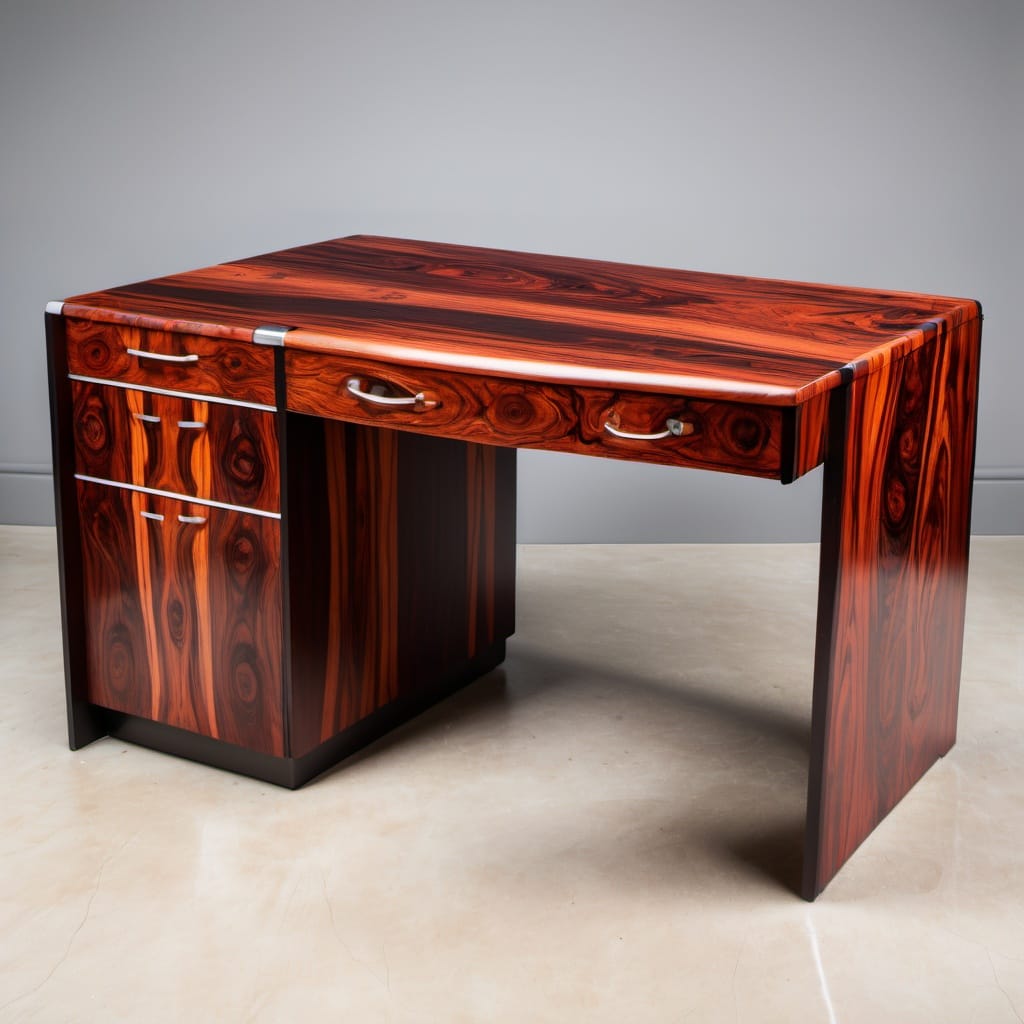Ever wondered about cocobolo desk? These pieces, made from rare Central American hardwood, are loved by many. They stand out with their beautiful colors, detailed grain, and lasting quality. Cocobolo desks are among the most sought-after and valuable furniture globally.
So, what makes cocobolo wood so special? Why do famous designers love it? And why should you think about getting a cocobolo desk for your home?
Key Takeaways
- Cocobolo wood is prized for its deep, reddish-brown hues and intricate grain patterns that create a striking visual appeal.
- Cocobolo furniture, including desks, is considered among the most expensive and exclusive in the world due to its rarity and exceptional craftsmanship.
- Historic Mexican furniture designer Don S. Shoemaker incorporated cocobolo wood into many of his iconic designs, which are now highly sought after.
- Cocobolo wood is incredibly durable and resistant to rot and insect damage, making it suitable for both indoor and outdoor use.
- The slow-growing nature of the cocobolo tree and its vulnerable status have contributed to the high value and exclusivity of cocobolo furniture.
Understanding the Exotic Appeal of Cocobolo Wood
Cocobolo, also known as Mexican rosewood, is a wood loved by many. It comes from the area between Mexico and Panama. This wood is very dense, almost as dense as African Blackwood.
The cocobolo wood is special because of its natural traits. These traits make it very popular among woodworkers and furniture makers.
Origins and Natural Characteristics
Cocobolo trees grow in the warm forests of Central America. They thrive in the tropical climate. The wood is easy to work with, making it perfect for beautiful pieces.
When first cut, cocobolo shows off vibrant patterns and colors. Over time, these colors deepen, giving the wood a rich look.
Unique Color Variations and Grain Patterns
Cocobolo wood is known for its wide range of colors. It can be deep reds, purples, warm browns, or vibrant oranges. Each piece is unique, making cocobolo furniture and accessories stand out.
Durability and Natural Properties
Cocobolo wood is not just beautiful; it’s also very durable. It resists moisture and wear well, thanks to its natural oils. This makes it great for high-end furniture and musical instruments.
Its ability to enhance sound makes it a top choice for string instruments. Woodworkers love it for these qualities.
The appeal of cocobolo wood is clear. It attracts both artisans and collectors with its beauty and durability. Learning about cocobolo is a journey into the world of fine woodworking and exceptional craftsmanship.
The Legacy of Cocobolo Desk Craftsmanship
Cocobolo wood has always fascinated top furniture designers. Don S. Shoemaker, from Nebraska, trained at the Art Institute of Chicago. He moved to Mexico in the late 1940s and started Señal S.A., known for Mid-Century Modernist Mexican furniture.
Shoemaker’s company was famous for its skill. They made both common and unique pieces, like the Cocobolo “Diamond Line Desk.” This desk, with its special diamond pattern, was a masterpiece. Only 25 were made, making them very valuable to collectors.
The beauty of cocobolo desks goes beyond Shoemaker’s work. Designers like Hans Wegner and Charles and Ray Eames also used it. They brought elegance and innovation to furniture, making it more accessible.
Even education has been influenced by cocobolo wood. James Krenov taught at the College of the Redwoods Fine Furniture program. He focused on respecting wood, mastering hand skills, and expressing oneself through design. His teaching has inspired many woodworkers.
| Designer | Notable Creations | Impact |
|---|---|---|
| Don S. Shoemaker | Cocobolo “Diamond Line Desk” | Pioneered Mid-Century Modernist furniture in Mexico |
| Hans Wegner | Integrating cocobolo wood into innovative designs | Influential in the Mid-Century Modernist movement |
| James Krenov | “The Bicycle” cabinet (1980), “The Music Stand” (1989) | Developed a renowned teaching philosophy at the College of the Redwoods Fine Furniture program |
The lasting impact of cocobolo desk craftsmanship shows its timeless beauty. Designers like Don S. Shoemaker and James Krenov have left a mark. Their work continues to inspire furniture lovers everywhere.
Why Invest in a Cocobolo Desk
Looking for a top-notch piece of furniture? A cocobolo desk is a rare gem. It’s known for its beauty and durability, attracting collectors and design fans.
Investment Value and Rarity
Cocobolo desks are rare and valuable. The trees that grow this wood are hard to find. Working with it is tough because it’s toxic when cut or sanded.
These desks are a smart investment. The cheapest ones cost over $7,000. Designer pieces can go for up to $16,000 or more.
Aesthetic Impact in Professional Spaces
Cocobolo desks also boost the look of any office. Their rich colors and detailed grain patterns make them stand out. They become the focal point of any room.
This makes a workspace look more prestigious. It impresses clients and colleagues, leaving a lasting impression.
Cultural Significance and Media Recognition
Cocobolo desks have become culturally significant. They’ve been seen in TV shows like Breaking Bad and Better Call Saul. Saul Goodman’s office features one.
This exposure has made cocobolo desks more popular. They’re now sought after by collectors and design lovers.
Buying a cocobolo desk is more than getting a beautiful desk. It’s about the wood’s rich history and cultural value. With its beauty, investment potential, and fame, a cocobolo desk is a masterpiece.
Caring for Your Cocobolo Desk
Keeping your cocobolo desk looking great needs some extra care. This wood is special because it’s dense and oily. This makes it a bit tricky to take care of.
Applying finishes like glue or lacquer can be hard because of the oils. Make sure finishes dry completely before adding more. Or, seal the wood’s oils first to help the new finish stick better.
When working with cocobolo, always wear protective gear like dust masks and gloves. It can cause allergies in some people, like asthma or dermatitis. Wearing the right gear helps keep you safe.
To keep the wood’s color and beauty, dust it regularly and avoid direct sunlight. Its dense and oily nature protects it from weather and bugs. But, regular care makes it last even longer.
By following these easy steps, your cocobolo desk will stay beautiful for many years. The effort you put in will pay off with a stunning piece of craftsmanship. It will show off the natural beauty of cocobolo.
Alternatives to Cocobolo Desks
Looking for something like cocobolo but cheaper? Mid-century furniture designers have got you covered. Rosewood, used by Hans Wegner, looks similar to cocobolo but costs less.
Other woods like cherry, red cedar, maple, walnut, and pine also offer elegance. They vary in durability, beauty, and price, making them great for those on a budget.
Designers like Erik Buch, Johannes Andersen, and Kai Kristiansen used rosewood. They made desks that look like cocobolo but are more affordable. These affordable luxury desks are perfect for those who love fine wood but don’t want to spend a lot on a cocobolo desk.
| Wood Type | Aesthetic Appeal | Durability | Affordability |
|---|---|---|---|
| Rosewood | Similar to cocobolo | Moderately durable | More affordable than cocobolo |
| Cherry | Warm, rich tones | Durable | Moderately priced |
| Red Cedar | Distinctive reddish hue | Highly durable | Relatively affordable |
| Maple | Clean, light appearance | Extremely durable | Budget-friendly |
| Walnut | Rich, dark tones | Moderately durable | Mid-range pricing |
| Pine | Rustic, casual aesthetic | Moderately durable | Highly affordable |
These cocobolo desk alternatives may not be as rare as cocobolo. But they offer a way to get the elegance of fine wood furniture without breaking the bank.
The Environmental Impact of Cocobolo Wood
Cocobolo wood is a rare tropical hardwood known for its beauty and sound quality. It’s highly valued for fine furniture and musical instruments. But, its rarity and endangered status raise concerns about how it’s harvested.
Cocobolo trees are listed as “vulnerable” on the IUCN Red List. Their population has dropped by 20% in the last three generations. This decline is mainly due to overlogging, which has reduced natural forests. The trees grow very slowly, taking about 80 years to reach maturity.
Despite these challenges, cocobolo wood has a positive side. It absorbs and stores carbon, making it eco-friendly. Practices like selective logging and reforestation are key to saving the cocobolo ecosystem.
As demand for cocobolo wood grows, designers look for alternatives. They want to keep its beauty without harming the environment. Sustainable wood sources and new ways to make products might help.
| Metric | Value |
|---|---|
| Deforestation Impact | Approximately 27,000 hectares of forest lost daily |
| Global Wood Production | Over 4.2 billion cubic meters of wood products annually |
| Biodiversity Impact | Estimated extinction rate of 1,000 species annually due to deforestation |
| Comparative Sustainability | Wood has lower CO2 emissions and energy consumption compared to materials like brick and steel |
The story of cocobolo wood is complex, with both problems and solutions. By finding new ways and managing resources wisely, we can enjoy its beauty while protecting the environment.
Conclusion
Cocobolo desks are the top choice for luxury and skill in exotic wood furniture. They are rare, beautiful, and carry cultural value. This makes them very popular among collectors and design fans.
Their high price and environmental worries might make them hard to get. But cocobolo’s charm keeps inspiring furniture designs and a love for fine woodworking.
Investing in a real luxury cocobolo desk or looking at more affordable options, cocobolo’s appeal is unmatched. Its stunning colors, lasting quality, and value make it a treasured item. It’s perfect for those who love top-notch quality and creativity in their spaces.
As cocobolo’s popularity worldwide increases, it’s key to value this material responsibly. Supporting ethical and green suppliers lets us enjoy cocobolo’s beauty. It also helps protect this valuable resource for the future.
FAQ
What is a cocobolo desk?
A cocobolo desk is a piece of furniture made from cocobolo wood. It’s known for its beautiful colors and patterns. The wood has a shiny finish that looks like lacquer.
What are the unique characteristics of cocobolo wood?
Cocobolo wood comes from Central America. It’s very dense, almost as dense as African Blackwood. When cut, it shows vibrant patterns that darken over time.
The wood smells floral and is very durable. This is because of its natural oils.
Who was Don S. Shoemaker, and how did he contribute to cocobolo furniture design?
Don S. Shoemaker was a famous Mexican designer. He worked with cocobolo wood in the 1960s and 70s. He founded Señal S.A. and created the “Cocobolo Diamond Line Desk.”
Why are cocobolo desks valuable investments?
Cocobolo desks are rare and valuable. The tree is limited and the wood is toxic when cut. This makes the desks highly sought after.
They are also famous for being featured in TV shows like Breaking Bad.
How should one care for a cocobolo desk?
Cocobolo wood needs special care. Allow finishes to dry before applying them. Seal the wood first to protect it.
When working with cocobolo, wear masks and gloves. This prevents allergic reactions. Dusting and avoiding sunlight helps keep the wood looking good.
What are some alternatives to a cocobolo desk?
If you want something like cocobolo but cheaper, consider other woods. Rosewood, cherry, red cedar, maple, walnut, and pine are good options. They offer different looks and prices.
What are the environmental concerns surrounding cocobolo wood?
Cocobolo trees are considered vulnerable. This means trade is closely monitored. It’s harder to find cocobolo wood, which raises questions about sustainability.





